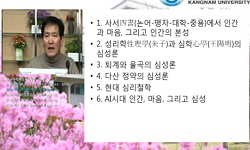이 글은 명대의 고승인 감산대사가 정곤암 중승에게 답하는 법어이다. 초심자가 깨달음을 얻기 위한 방법의 핵심을 다루고 있는 이 글은 선가에서 날마다 암송할 정도로 중요한 내용을 담고...
http://chineseinput.net/에서 pinyin(병음)방식으로 중국어를 변환할 수 있습니다.
변환된 중국어를 복사하여 사용하시면 됩니다.
- 中文 을 입력하시려면 zhongwen을 입력하시고 space를누르시면됩니다.
- 北京 을 입력하시려면 beijing을 입력하시고 space를 누르시면 됩니다.

憨山德清의 <答鄭崐巖中丞> 역주 = The Translation and Annotation of Hanshan Deqing’s “Answer to Zheng kunyan (Da Zheng Kunyan Zhongcheng 答鄭崐巖中丞)”
한글로보기https://www.riss.kr/link?id=A108945787
-
저자
류창교 (한국조지메이슨대학교)
- 발행기관
- 학술지명
- 권호사항
-
발행연도
2024
-
작성언어
Korean
-
주제어
감산대사 ; 수행 ; 마음 ; 깨달음 ; 해오(解悟) ; 증오(證悟) ; 초심 ; Master Hanshan ; practice ; mind ; enlightenment ; realization through understanding ; realization through experience ; the original intention
-
등재정보
KCI등재
-
자료형태
학술저널
-
수록면
255-291(37쪽)
- DOI식별코드
- 제공처
-
0
상세조회 -
0
다운로드
부가정보
국문 초록 (Abstract)
이 글은 명대의 고승인 감산대사가 정곤암 중승에게 답하는 법어이다. 초심자가 깨달음을 얻기 위한 방법의 핵심을 다루고 있는 이 글은 선가에서 날마다 암송할 정도로 중요한 내용을 담고 있다. 이 글의 내용은 크게 네 가지로 정리할 수 있다. 첫째, 우리 마음의 본체는 본래 거울과 같이 맑고 깨끗하나 오랫동안 애욕과 망상이 뿌리 깊게 자리 잡고 있어 용맹정진하지 않고서는 그것을 뽑아내기 어렵다. 둘째, 오직 마음이 법의 문임을 확실히 믿어야 하며, 오직 염불하며 실제를 아는 화두만이 세속의 번뇌에서 가장 쉽게 힘을 얻는다. 셋째, 깨달음에는 해오(解悟)와 증오(證悟)가 있다. “해오”는 알음알이로 대부분 장애를 만나게 되니 진짜로 깨달은 것은 아니다. “증오”는 자기 마음속으로부터의 진실한 깨달음으로 다시는 의심할 수 없어 식견과 쓸데없는 생각, 감정과 근심을 깨끗하게 없앤다. 마지막으로 감산대사는 깨달음을 얻는 여섯 가지 원칙으로, “첫째, 현묘함을 구해서는 안 된다. 둘째, 마음으로 깨달음을 기다려서는 안 된다. 셋째, 묘한 결과를 바라면 안 된다. 넷째, 스스로 의심하고 근심해서는 안 된다. 다섯째, 두려움을 일으키면 안 된다. 여섯째, 자신의 마음이 부처임을 믿기로 결정해야 한다.”고 하였다. 그러나 “이 몇 가지는 사족이며, 부처님의 확철대오의 길은 점진적인 과정과는 관련이 없고”, “그것은 초심의 방편에 있다.”는 것을 강조하였다.
다국어 초록 (Multilingual Abstract)
The contents of this Dharma talk can be organized into four parts. First, our mind itself is originally clear like a mirror, but lust and delusion have been deeply rooted for a long time, so it is difficult to pull them out without courage and perseverance. Second, you must firmly believe that only the mind is the door to the Dharma, and only those who chant and know the reality can most easily gain strength from worldly troubles. Third, there are two types of enlightenment. One is gaining enlightenment through understanding, the other is gaining enlightenment through experience. The former is not truly enlightened because it encounters obstacles most of the time. Whereas the latter is a true realization, completely eliminating insight, useless thoughts, emotions, and worries. Lastly, Master Hanshan outlines the six principles of enlightenment by performing: “First, you should not seek mysticism. Second, you should not wait for enlightenment. Third, you should not expect strange results. Fourth, you should not doubt yourself and worry. Fifth, you should not cause fear. Sixth, you must decide to believe that your mind is Buddha.” However, he emphasized that “these few things are redundant, and the path of the Buddha’s great enlightenment is not related to the path,” and “it lies in the means of the original intention.”
“Answer to Zheng Kunyan (Da Zheng Kunyan Zhongcheng 答鄭崐巖中丞) is a Dharma talk written by Master Hanshan, a famous scholarly monk of the Ming Dynasty. This is a concise and easy Dharma talk written about the essence of the human mind taugh...
“Answer to Zheng Kunyan (Da Zheng Kunyan Zhongcheng 答鄭崐巖中丞) is a Dharma talk written by Master Hanshan, a famous scholarly monk of the Ming Dynasty. This is a concise and easy Dharma talk written about the essence of the human mind taught in Zen Buddhism. This Dharma talk, which deals with the core of the method for beginners to achieve enlightenment, is so important that it is recited every day in Zen schools.
The contents of this Dharma talk can be organized into four parts. First, our mind itself is originally clear like a mirror, but lust and delusion have been deeply rooted for a long time, so it is difficult to pull them out without courage and perseverance. Second, you must firmly believe that only the mind is the door to the Dharma, and only those who chant and know the reality can most easily gain strength from worldly troubles. Third, there are two types of enlightenment. One is gaining enlightenment through understanding, the other is gaining enlightenment through experience. The former is not truly enlightened because it encounters obstacles most of the time. Whereas the latter is a true realization, completely eliminating insight, useless thoughts, emotions, and worries. Lastly, Master Hanshan outlines the six principles of enlightenment by performing: “First, you should not seek mysticism. Second, you should not wait for enlightenment. Third, you should not expect strange results. Fourth, you should not doubt yourself and worry. Fifth, you should not cause fear. Sixth, you must decide to believe that your mind is Buddha.” However, he emphasized that “these few things are redundant, and the path of the Buddha’s great enlightenment is not related to the path,” and “it lies in the means of the original intention.”
동일학술지(권/호) 다른 논문
-
중한번역에서 나타나는同形異義語 오역과 사전 정의 고찰 — 중국군 단위부대 명칭을 중심으로
- 중국어문논역학회
- 김상규
- 2024
- KCI등재
-
한국어 인용구문에서 문법화된 “-더라니”와 중국어의 대응 표현 연구 — 비환원적 “예측대로 되었음”의 “-더라니”를 중심으로
- 중국어문논역학회
- 왕정
- 2024
- KCI등재
-
- 중국어문논역학회
- 강운화
- 2024
- KCI등재
-
- 중국어문논역학회
- 이창호
- 2024
- KCI등재




 DBpia
DBpia






